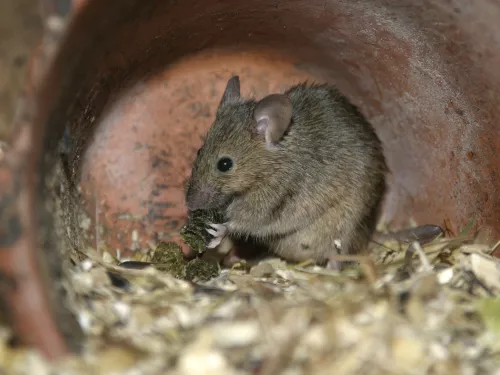Hornet mimic hoverfly
With black-and-yellow markings, the hornet mimic hoverfly looks like its namesake, but is harmless to us. This mimicry helps to protect it from predators while it searches for nectar.
With black-and-yellow markings, the hornet mimic hoverfly looks like its namesake, but is harmless to us. This mimicry helps to protect it from predators while it searches for nectar.
With black-and-yellow markings, the Hornet robberfly looks like its namesake, but is harmless to us. This mimicry helps to protect it from predators while it perches in the open, waiting for its own prey.
Hornwrack is often found washed up on our beaches, with many believing that it is dried seaweed. In fact, it is a colony of animals!
A tall, broad tree of woodlands, roadsides and parks, the introduced horse chestnut is familiar to many of us the 'conker' producing tree - its shiny, brown seeds appearing in their spiny cases in autumn.
Horsehair worms are parasitic worms of the clade Nematoida alongside their sister taxa Nematoda, the roundworms. The most famous trait of certain species of horsehair worms is the ability to alter the behaviour of grasshoppers and crickets to seek water, causing the host to drown itself to complete its lifecycle.
Horseradish is used as a well-loved condiment. This member of the cabbage family is actually an introduced species in the UK, but causes no harm in the wild.
Horseshoe vetch is a member of the pea family, so displays bright yellow, pea-like flowers and seed pods. Look for this low-growing plant on chalk grasslands from May to July.
As its name suggests, the house martin can be spotted nesting in the eaves of houses in our towns and villages. Its intricate mud nests take days to build and are often returned to and used in following years.

The tiny, grey-brown house mouse is one of our most successful mammals. It thrives around buildings but is less likely to be found in our houses these days due to better construction.
The house sparrow is a familiar, streaky brown bird of towns, parks and gardens. Males sport a grey cap and black bib, the size of which indicates their status.
The humming-bird hawk-moth migrates to the UK from Southern Europe each year. It can be seen hovering over flowers, feeding with its long proboscis; its wings move so quickly that it 'hums'.
The humpback whale is making a comeback, with more and more individuals being seen in UK seas every year. They are well known for their acrobatic behaviour - so don't be surprised to see them breach clear of the water!